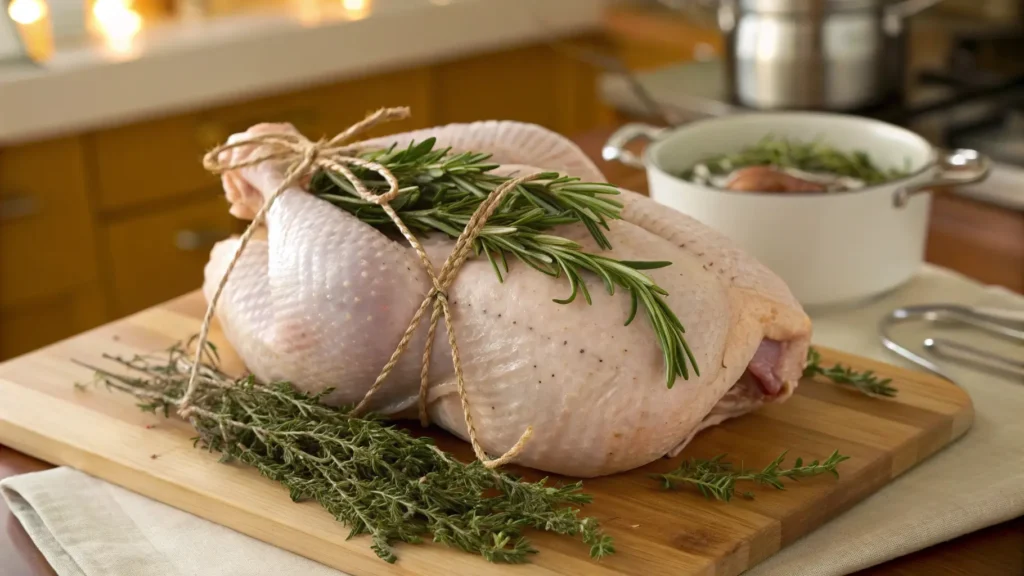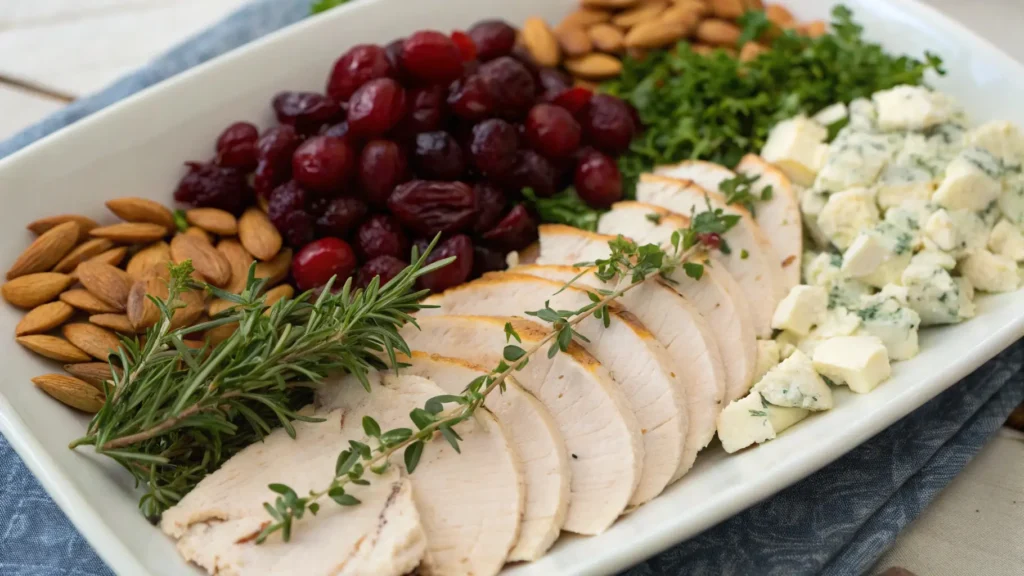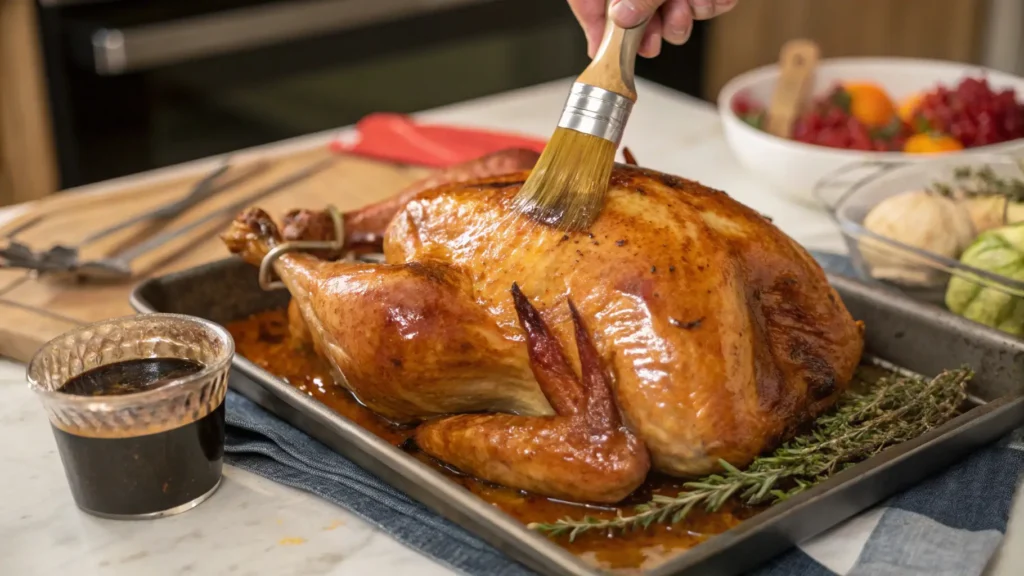A golden, perfectly seasoned turkey is the crowning glory of any holiday table. But have you ever wondered, what to put on top of turkey before cooking to make it irresistible? From buttery glazes to aromatic herbs, there are countless ways to elevate your bird and create a masterpiece. This guide dives deep into methods, ingredients, and tips to ensure your turkey steals the show.
We’ll explore why seasoning matters, the best ingredients to use, and the most effective techniques for flavor infusion. Whether you’re a seasoned chef or a kitchen newbie, you’ll find practical advice to make your turkey the centerpiece of your feast. Let’s get started!

Why Seasoning is Key for the Perfect Turkey
Why Bland Turkey Fails the Test
There’s nothing more disappointing than cutting into a beautifully roasted turkey only to discover it tastes… plain. Turkey meat, especially the breast, is naturally lean and mild in flavor. Without proper seasoning, it risks turning out dry and uninspiring. That’s why enhancing its flavor before cooking is essential—it’s your ticket to a bird that’s both juicy and flavorful.
The Science of Seasoning: Flavor Infusion Basics
When you season a turkey, you’re not just sprinkling salt and herbs for the heck of it. You’re creating a reaction that helps tenderize the meat while imparting flavor deep into the flesh. Methods like brining and using compound butter introduce moisture and seasoning directly into the turkey, ensuring every bite is packed with taste.
Moreover, layering flavors by using aromatics, fresh herbs, and marinades enhances the turkey’s natural essence while giving the skin that golden, crispy finish everyone craves. Whether you go bold with spices or stick to classic seasonings, it’s all about creating a harmonious balance.
In short, seasoning isn’t just a step—it’s the heart of a flavorful, show-stopping turkey.
Common Ingredients to Put on Top of Turkey

Butter and Compound Butter: A Flavorful Base
When it comes to what to put on top of turkey before cooking, butter is a classic choice that never fails. Slathering softened butter over the skin not only locks in moisture but also gives the turkey a beautifully crisp and golden exterior. For an elevated touch, try compound butter—a blend of butter, herbs, citrus zest, and spices.
Spread the butter generously over the turkey, making sure to get some under the skin. This technique ensures the meat absorbs all those wonderful flavors while keeping it juicy. A compound butter with rosemary, thyme, and orange zest can add a delightful aroma that fills your kitchen.
Fresh Herbs: Rosemary, Thyme, and Sage
Fresh herbs are another excellent way to enhance your turkey. Layer sprigs of rosemary, thyme, and sage on top of the bird or tuck them under the skin for deeper infusion. These herbs release their oils as the turkey roasts, creating a rich, earthy flavor that pairs perfectly with the natural taste of the meat.
For best results, combine herbs with butter or oil before spreading them over the turkey. This ensures they adhere to the surface and roast evenly, leaving the skin fragrant and crispy.
Aromatics: Citrus, Garlic, and Onions
Looking for more depth in flavor? Stuff your turkey cavity with aromatic ingredients like citrus halves, garlic cloves, and onions. These ingredients don’t just flavor the meat—they also infuse the drippings, making your gravy even more delicious.
You can also place slices of citrus and onions directly on top of the turkey. The juices from these aromatics seep into the skin during cooking, adding a subtle tang and sweetness. Combining citrus with fresh herbs and butter creates a well-rounded profile that’s sure to impress.
Popular Methods for Seasoning Turkey Before Cooking
Wet Brining: Submerging in a Flavor Bath
Wet brining is a tried-and-true method for seasoning turkey. This process involves soaking the bird in a mixture of water, salt, sugar, and optional seasonings for several hours or even overnight. The brine helps the turkey retain moisture while evenly distributing flavor throughout the meat.
To prepare, dissolve salt and sugar in water, then add aromatics like bay leaves, peppercorns, and citrus slices. Submerge the turkey completely and refrigerate it for up to 24 hours. This method ensures a tender, juicy bird with every bite. Plus, it’s an excellent answer to what to put on top of turkey before cooking—you’ll find the brine does most of the heavy lifting!
Dry Brining: Spice Rubs and Refrigeration
If you prefer a simpler approach, dry brining is the way to go. This involves rubbing a blend of salt, spices, and sometimes sugar directly onto the turkey’s skin and letting it rest in the fridge.
Dry brining works by drawing out moisture, which then gets reabsorbed into the meat along with the seasoning. For the best results, let the turkey rest uncovered in the fridge for at least 12 hours. Dry brining not only enhances flavor but also helps achieve that coveted crispy skin.
Marinating: Enhancing with Liquids and Spices
Marinating is another flavorful option for those wondering what to put on top of turkey before cooking. A marinade typically consists of oil, an acid (like vinegar or citrus juice), and seasonings. It’s an excellent way to add layers of flavor while tenderizing the meat.
Apply the marinade generously over the turkey, ensuring it’s fully coated, and let it rest in the fridge for several hours. For even more impact, use a flavor injector to distribute the marinade deep into the meat. This technique is especially useful for larger birds where surface seasoning might not reach the inner layers.
By experimenting with these popular methods, you can create a turkey that’s bursting with flavor and guaranteed to be the star of your holiday table.
Enhancing Turkey with Glazes and Bastes

Sweet and Savory Glazes for a Caramelized Finish
Glazes are a fantastic way to add a touch of elegance and flavor to your turkey. A glaze, typically made from ingredients like honey, maple syrup, or brown sugar, creates a shiny, caramelized crust that not only looks stunning but tastes incredible.
For a savory twist, consider adding soy sauce, Dijon mustard, or Worcestershire sauce to your glaze. Brush the glaze over the turkey during the last 30 minutes of cooking to avoid burning. This step enhances the golden-brown appearance while infusing the meat with a sweet and savory depth of flavor.
Basting Techniques: When and How to Do It Right
Basting is another effective way to keep your turkey juicy and full of flavor. While many rely on pan drippings, you can use melted butter or a mixture of stock and spices to baste. The key is to avoid overdoing it—opening the oven too frequently can cause heat loss, lengthening cooking time and drying out the bird.
Instead, baste every 30–45 minutes during the cooking process. This method ensures that the skin stays moist and flavorful without compromising the texture. A well-basted turkey not only tastes better but also delivers that irresistible, crisp skin everyone loves.
Pro Tips for Turkey Cooking Success
Layering Flavors: What Goes Under the Skin?
Wondering what to put on top of turkey before cooking for maximum flavor? Don’t forget to season under the skin! This often-overlooked area can hold a surprising amount of flavor. Gently separate the skin from the meat and spread a mixture of butter, herbs, and spices underneath.
This technique ensures that the seasoning penetrates deep into the meat while keeping the skin crispy and golden. You can even add slices of garlic or thin citrus wedges for an extra burst of flavor.
Using Injectors for Maximum Flavor Penetration
For the most thorough seasoning, consider using a flavor injector. This handy tool lets you infuse the turkey with marinades, melted butter, or broth directly into the meat. It’s especially helpful for large birds, where surface seasoning might not reach every bite.
Choose a marinade with fine ingredients to avoid clogging the injector. Inject the marinade into multiple spots across the turkey, ensuring even distribution. This approach guarantees a moist, flavor-packed bird that’s sure to impress your guests.
For more ideas on turkey preparation, check out the recipe article “Should I Rub Butter or Oil on My Turkey?” on TangleRecipes. It’s a great resource for making informed decisions about turkey cooking techniques!
FAQs: What People Also Ask
Do You Put Butter or Oil on Turkey Before Cooking?
One of the most common questions cooks ask is whether to use butter or oil on turkey. Both have their benefits, but the choice often depends on your goal. Butter adds richness and flavor, while oil helps create a crisp, golden skin. Many chefs combine the two for the best of both worlds.
When thinking about what to put on top of turkey before cooking, consider slathering the bird with softened butter under the skin for deeper flavor. Then, lightly brush oil over the exterior to promote browning and crispiness. This technique gives you a beautifully cooked turkey inside and out.
What Herbs Are Best for Turkey?
Fresh herbs can make or break a turkey’s flavor profile. Popular choices include rosemary, thyme, and sage for their earthy, aromatic qualities. For a brighter twist, try parsley, oregano, or marjoram.
When deciding what to put on top of turkey before cooking, layer these herbs directly on the skin or mix them with butter for a flavorful spread. Herbs also work wonders when stuffed into the cavity along with aromatics like garlic or citrus. The result? A turkey that’s infused with delightful herbaceous notes.
How to Prevent Turkey From Drying Out?
Dry turkey is every cook’s worst nightmare, but a few strategies can keep it juicy. First, consider wet or dry brining to lock in moisture. Next, use a meat thermometer to avoid overcooking—aim for 165°F at the thickest part of the breast.
Another secret? Basting! Regularly spoon pan juices over the bird to keep the surface moist and flavorful. And don’t forget: what you put on top of the turkey before cooking—whether it’s butter, herbs, or a glaze—can make all the difference in achieving a tender, juicy result.
Final Touches and Presentation
Plating Your Turkey with Garnishes
The final impression of your turkey is just as important as its flavor. When plating your bird, consider garnishing it with fresh herbs like rosemary and parsley or colorful citrus slices. These elements not only add visual appeal but also hint at the flavors within.
For a festive touch, surround the turkey with roasted vegetables or cranberries. A well-garnished turkey doesn’t just look beautiful—it enhances the overall dining experience for your guests.
Serving Suggestions for a Memorable Feast
Pairing your turkey with complementary sides and sauces can elevate the meal. Classic options like mashed potatoes, stuffing, and cranberry sauce work beautifully. If you’ve prepared pan drippings, turn them into a rich gravy for drizzling over the turkey.
When it’s time to carve, slice carefully to maintain the meat’s juices and texture. Arrange the pieces neatly on a platter, ensuring that both white and dark meat are easily accessible. With a little care, your turkey will be the show-stopping centerpiece your guests will remember for years to come.
Suggestion for Additional Reading
For more turkey tips and tricks, don’t miss the article “What Makes Turkey Breast Tough?” on TangleRecipes. It offers valuable insights into achieving tender, flavorful turkey every time!

